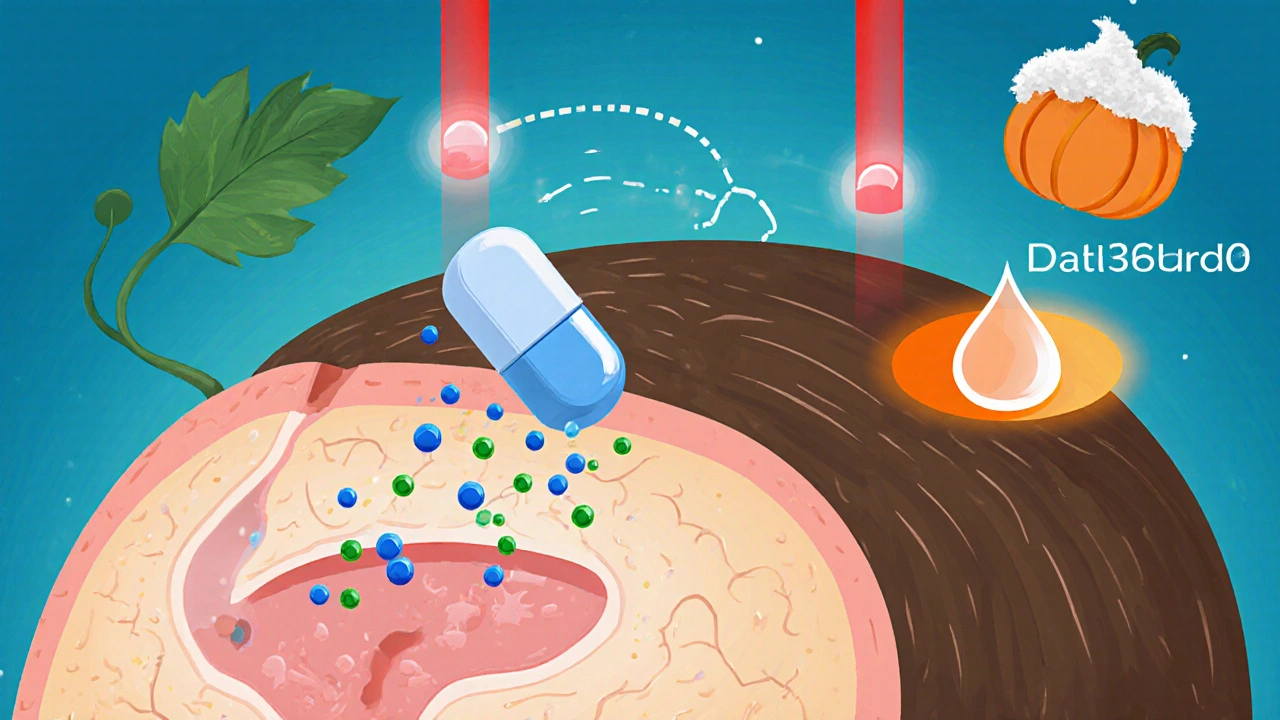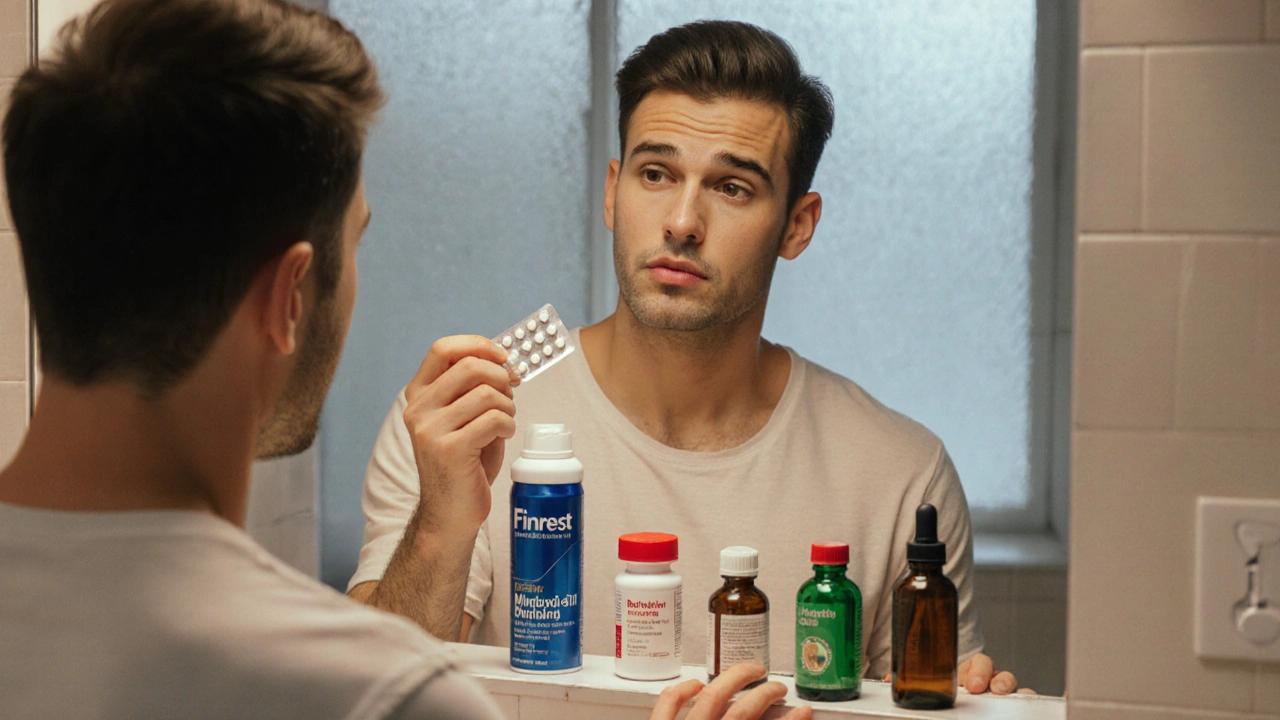Hair Loss Treatment Advisor
Personalized Treatment Recommendations
Answer a few simple questions about your situation to get tailored recommendations based on the latest clinical data.
Your Recommendations
Based on latest clinical data (2018-2024) and the article content
Answer the questions above to get personalized treatment recommendations.
When you’ve tried every shampoo and still see more scalp than hair, it’s time to look at medication. Finrest is the NewZealand brand name for finasteride, a 5‑alpha‑reductase inhibitor approved for male‑pattern baldness and benign prostatic hyperplasia (BPH). But finasteride isn’t the only player in town. Below you’ll find a side‑by‑side look at the most common alternatives, so you can decide whether to stick with Finrest or switch gears.
What Finrest Does and How It’s Used
Finrest works by blocking the enzyme that converts testosterone into dihydrotestosterone (DHT), the hormone that shrinks hair follicles on the crown and front of the scalp. In a typical regimen you take one 1mg tablet daily, and noticeable regrowth can start after three to six months. Most clinical trials report a 25‑30% increase in hair count compared with placebo.
Popular Alternatives at a Glance
- Dutasteride - a stronger 5‑alpha‑reductase inhibitor that targets both TypeI and TypeII enzymes.
- Minoxidil - a topical vasodilator applied twice a day that boosts blood flow to hair follicles.
- Low‑Level Laser Therapy (LLLT) - a non‑invasive device that delivers red light to stimulate cellular activity.
- Saw Palmetto - a plant extract often marketed as a natural DHT blocker.
- Pumpkin Seed Oil - another oral supplement that may reduce DHT levels.
- Spironolactone - a potassium‑sparing diuretic with anti‑androgen effects, mainly used off‑label for women.
- Hair Transplant Surgery - a procedural option that relocates healthy follicles to balding zones.

Side‑by‑Side Comparison
| Attribute | Finrest (Finasteride) | Dutasteride | Minoxidil | LLLT | Saw Palmetto | Pumpkin Seed Oil |
|---|---|---|---|---|---|---|
| Mechanism | 5‑α‑reductase inhibitor (TypeII) | 5‑α‑reductase inhibitor (TypeI&II) | Topical vasodilator | Red‑light stimulation of follicle cells | Natural DHT blocker (plant sterols) | Phyto‑DHT reduction (rich in zinc) |
| FDA approval (US) | Yes - hair loss & BPH | Yes - BPH (hair loss off‑label) | Yes - hair loss | Yes - medical devices | No - dietary supplement | No - dietary supplement |
| Typical dose | 1mg oral daily | 0.5mg oral daily | 2% solution, 1mL twice daily | 2‑4min sessions, 3times/week | 320mg capsule daily | 1tsp oil daily |
| Hair‑count increase* | 25‑30% | 30‑35% | 15‑20% | 10‑15% | 5‑10% | 5‑8% |
| Common side effects | Reduced libido, ejaculation issues (2‑5%) | Similar but slightly higher incidence | Scalp irritation, itching | None reported | Rare GI upset | Rare allergic reaction |
*Results taken from pooled clinical studies performed between 2018‑2024. Individual response varies.
Pros and Cons of Finrest Compared to Each Alternative
- Finrest vs Dutasteride: Dutasteride hits both enzyme types, so it may give a few extra points in hair‑count, but the trade‑off is a slightly higher risk of sexual side effects. Finrest remains the go‑to first‑line because it’s cheaper and has decades of safety data.
- Finrest vs Minoxidil: Minoxidil is easy to add on and works on both men and women, but you need to keep applying for life and many users complain about scalp dryness. Finrest is a once‑daily pill, which many find more convenient.
- Finrest vs LLLT: Laser caps are painless and side‑effect‑free, yet the evidence for a meaningful hair‑count boost is modest. Finrest delivers a bigger percentage gain for a fraction of the device cost.
- Finrest vs Saw Palmetto: The plant extract is appealing for those who hate prescription meds, but clinical trials show only a minimal DHT drop. Finrest’s effect is both stronger and more predictable.
- Finrest vs Pumpkin Seed Oil: Pumpkin seed oil is safe and inexpensive, but the hair‑growth data hover around the low single digits. Finrest outperforms it dramatically in head‑to‑head studies.
- Finrest vs Spironolactone: Spironolactone is the main oral option for women, not men. If you’re male, it can cause unwanted feminising effects, whereas Finrest targets the male‑specific DHT pathway.
- Finrest vs Hair Transplant: Surgery gives permanent, dense coverage in the treated zone, but it’s costly, invasive, and not a solution for early‑stage thinning. Finrest can halt further loss and add modest regrowth without surgery.
How to Choose the Right Option for You
Think of the decision as a checklist:
- Stage of hair loss: If you’re just starting to see a receding hairline, a DHT blocker like Finrest or Dutasteride often halts the drift. Advanced balding may need a transplant or combination therapy.
- Tolerance for daily pills: Some people dislike swallowing medication. In that case, Minoxidil or LLLT provide non‑oral routes.
- Side‑effect sensitivity: If you’ve experienced sexual side effects on finasteride before, try Dutasteride at a lower dose or switch to a topical approach.
- Budget: Finrest costs roughly NZ$30‑40 per month. LLLT devices start at NZ$300‑500, while a single hair‑transplant session can exceed NZ$6,000.
- Long‑term commitment: All medical treatments need ongoing use. If you’re okay with lifelong maintenance, a pill or foam works. If you prefer a one‑time fix, surgery is the only permanent route.
Most men end up on a combo: Finrest to keep DHT low, plus Minoxidil for the extra follicle stimulation. That pair delivers a synergy that the table shows as the highest average hair‑count increase.

Quick Troubleshooting Guide
- No visible regrowth after 6months? Check adherence - missed doses wipe out the benefit. Consider adding Minoxidil or stepping up to Dutasteride.
- Experiencing sexual side effects? Discuss a lower dose with your GP, or switch to an intermittent schedule (e.g., 5days on, 2days off) which some users find helpful.
- Scalp irritation from Minoxidil? Try the foam formulation or reduce application to once daily.
- Considering LLLT? Ensure the device emits 630‑660nm wavelength; cheaper LEDs often lack the proper specs.
Frequently Asked Questions
Is Finrest safe for long‑term use?
Yes. Over 20years of data show that daily 1mg finasteride remains well‑tolerated for most men. Regular check‑ins with your doctor help catch any rare side effects early.
Can I combine Finrest with Minoxidil?
Absolutely. The two work through different pathways - Finrest blocks DHT while Minoxidil boosts follicle blood flow. Clinical trials report up to a 55% improvement when used together.
What’s the difference between Finrest and Dutasteride?
Finrest targets only TypeII 5‑α‑reductase; Dutasteride blocks both TypeI and TypeII, giving a slightly stronger DHT reduction. The trade‑off is a modest increase in side‑effect frequency.
Are natural supplements like Saw Palmetto effective?
Evidence is mixed. Small trials show a 5‑10% hair‑count improvement, far below prescription blockers. They may be worth trying if you can’t tolerate any pill, but set realistic expectations.
When should I consider hair‑transplant surgery?
If you’ve reached a stable stage of loss (no further recession for 12‑18months) and want a permanent, dense look, surgery is the only curative option. It’s best paired with a DHT blocker to protect the grafts.
Next Steps
Start by booking a quick appointment with your GP or a dermatologist. Bring a list of the options above and ask about a trial of Finrest - most doctors will prescribe a 3‑month supply to gauge response. If side effects pop up, discuss dose tweaks or a switch to Dutasteride. For those who hate pills, ask about a combined Minoxidil + LLLT plan.
Remember, hair loss is a marathon, not a sprint. Consistency, realistic goals, and a clear understanding of each option’s strengths will get you the best results.

Boston Farm to School
October 14, 2025 AT 15:22Finrest is cheap and works for most guys.
Emily Collier
October 18, 2025 AT 02:42The table makes it clear that finasteride has a solid evidence base, especially when you compare the 25‑30% hair‑count increase to the lower numbers for natural supplements. It’s also reassuring that the side‑effect profile is well‑documented after decades of use. If you’re sensitive to sexual side effects, starting at a low dose and monitoring with your doctor can mitigate many concerns. Combining it with a topical like minoxidil can boost results without significantly raising risk. Overall, think of finasteride as the backbone of a medically‑driven regimen.
Catherine Zeigler
October 21, 2025 AT 14:02When you read through the comparison, a few themes emerge that are worth emphasizing. First, the magnitude of hair‑count increase directly follows how aggressively the treatment targets DHT; dutasteride, which blocks both Type I and Type II enzymes, edges out finasteride by a few points, but that small gain comes with a modest uptick in reported sexual side effects. Second, the convenience factor cannot be overstated: a once‑daily pill like finasteride fits easily into most people's routines, whereas minoxidil demands twice‑daily application and vigilance about scalp irritation. Third, cost considerations are practical – finasteride sits comfortably in the low‑to‑medium budget bracket, whereas laser devices or transplant surgery quickly become prohibitive for most. Fourth, the evidence hierarchy shows that prescription‑only agents consistently outperform over‑the‑counter botanicals; saw palmetto and pumpkin seed oil may be attractive to those averse to pills, yet their reported hair‑count improvements rarely exceed single‑digit percentages. Fifth, individual response variability remains high, so patience and adherence are key – a meaningful difference often only becomes visible after six months of consistent use. Sixth, for those who have already experienced sexual side effects, an intermittent dosing schedule (for example five days on, two days off) has anecdotal support and may reduce impact without sacrificing efficacy. Seventh, combining modalities – such as finasteride plus minoxidil – leverages distinct mechanisms (hormonal blockade plus follicular stimulation) and has been shown in trials to produce the highest average improvement. Eighth, laser therapy offers a side‑effect‑free option, yet the modest 10‑15% increase in hair count may not justify the upfront cost for many patients. Ninth, surgical options like hair transplantation provide permanent coverage but are best reserved for stable, advanced loss where medical therapy alone cannot restore density. Tenth, regular follow‑up with a clinician allows dose adjustments, monitoring of prostate health, and assessment of therapeutic response. Eleventh, lifestyle factors – adequate protein intake, controlled stress, and avoidance of harsh hair products – can complement pharmacologic treatment. Twelfth, the psychological benefit of even modest regrowth can be significant, improving confidence and quality of life. Thirteenth, be wary of online “miracle” claims; most lack rigorous data and often rely on placebo effects. Fourteenth, if you are a woman, finasteride is generally not recommended due to teratogenic risk, and alternatives like spironolactone or topical minoxidil become more relevant. Finally, the decision should balance efficacy, safety, cost, and personal preference – there is no one‑size‑fits‑all answer, but a thoughtful, evidence‑based approach will lead you to the best outcome for your situation.
henry leathem
October 25, 2025 AT 01:22From a mechanistic standpoint, finasteride's selectivity for Type II 5‑α‑reductase offers a pharmacodynamic profile that is optimally aligned with the androgen‑dependent pathophysiology of male‑pattern alopecia; however, the emergent literature on isoform redundancy suggests that adjunctive agents targeting complementary pathways, such as vasodilatory minoxidil or photobiomodulatory LLLT, can synergistically augment follicular proliferative indices, thereby transcending the ceiling effect inherent to monotherapy. Moreover, the pharmacokinetic half‑life of finasteride necessitates sustained plasma concentrations for DHT suppression, reinforcing adherence imperatives.
jeff lamore
October 28, 2025 AT 11:42Indeed, the pharmacological considerations you outlined are pertinent, yet it remains essential to contextualize these data within real‑world patient behavior. While the synergy between agents is theoretically appealing, the logistical burden of multiple daily applications often translates into diminished compliance, which can erode any incremental efficacy gains. Therefore, clinicians should weigh the marginal benefit against the practicalities of a patient’s daily routine before prescribing combination regimens.
Kris cree9
October 31, 2025 AT 23:02lol i get it u guys sound like a bunch of nerds but honestly finrest is just a pill u pop and hope u look less bald lol. i tried minoxi and my scalp was like "what the heck" 😂 no point in over‑thinking it.
John Babko
November 4, 2025 AT 10:22Finrest offers a cost‑effective, evidence‑based solution; however, patients should consider the comprehensive treatment landscape, including adjunctive options, potential side effects, and long‑term commitment before making a decision, especially given the variability in individual response.
Stacy McAlpine
November 7, 2025 AT 21:42Totally agree-starting with a proven DHT blocker like finrest makes sense, and if you’re open to adding a topical you can often see a noticeable difference without breaking the bank.
Roger Perez
November 11, 2025 AT 09:02Exactly! 😊 A solid base with finrest plus minoxidil gives you the best of both worlds-hormonal control and follicle stimulation. 💪🏽💈
Ian McKay
November 14, 2025 AT 20:22Minor correction: "follicle" should be pluralized as "follicles" when referring to multiple units, and "hormonal" requires a hyphen when used as a compound adjective before a noun, i.e., "hormonal‑control".